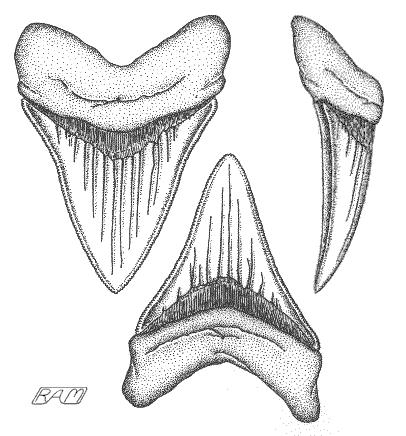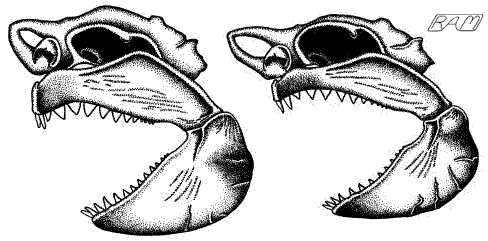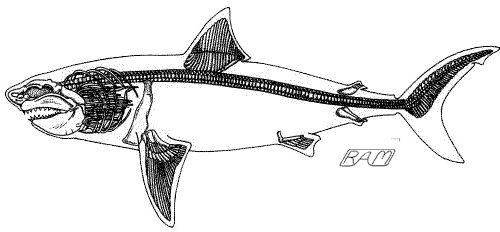Reconstructing Megalodon
Large fossilized Megalodon teeth are among the most startling of natural objects. They are huge blackish triangles that appear 'puffed up', resembling fresh-baked (fresh-burned?) cookies. The root is bilobed and rough, in stark contrast to the smooth, enamel-like polish of the blade. The blade itself is often cracked longitudinally and the edge has about 50 serrations per inch (20 per centimetre). The heft of a good-sized specimen is remarkable - about three-quarters of a pound (0.4 kilograms). It is hard to think of these massive stones as ever having been teeth. But that's exactly what they were. This undeniable fact has generated much awestruck speculation about what the entire shark must have looked like.
 Fossilized teeth are almost all that remains of Megalodon. Therefore,
placing some of these teeth in a model of the long-gone cartilaginous jaws
is an expedient way to start reconstructing this creature. But how many
teeth and how big to make the jaws? Since Megalodon teeth so closely
resemble those of the modern white shark in form but are about three times
as large, it seemed to early museum curators that a scaled-up model of White
Shark jaws would be a reasonable approximation. Despite their huge size,
these early reconstructions were not as scary-looking as one might imagine:
resembling gigantic, white lips filled with hundreds of blackish fossil
teeth. (Fossil shark teeth can be almost any color - black, purple, blue,
green, brown, red, pink, orange, yellow, beige, or almost white - depending
upon the precise chemistry of the sediment in which they were deposited.
Because most commercially-sold megalodon teeth come from Cooper River and
other South Carolina deposits rich in dark phosphates, these fossils are
almost always dark grey, brown, or black.) But the stand-in jaws did give an
impression of the sheer enormity of megalodon. Measuring eleven feet (3.4
metres) tall and nine feet (2.75 metres) across, the reconstructed megalodon
jaws suggested a monster shark more than 80 feet (25 metres) in length.
Small wonder that, even today, plaster reconstructions of Megalodon jaws are
among the most popular paleontological exhibits in museums.
Fossilized teeth are almost all that remains of Megalodon. Therefore,
placing some of these teeth in a model of the long-gone cartilaginous jaws
is an expedient way to start reconstructing this creature. But how many
teeth and how big to make the jaws? Since Megalodon teeth so closely
resemble those of the modern white shark in form but are about three times
as large, it seemed to early museum curators that a scaled-up model of White
Shark jaws would be a reasonable approximation. Despite their huge size,
these early reconstructions were not as scary-looking as one might imagine:
resembling gigantic, white lips filled with hundreds of blackish fossil
teeth. (Fossil shark teeth can be almost any color - black, purple, blue,
green, brown, red, pink, orange, yellow, beige, or almost white - depending
upon the precise chemistry of the sediment in which they were deposited.
Because most commercially-sold megalodon teeth come from Cooper River and
other South Carolina deposits rich in dark phosphates, these fossils are
almost always dark grey, brown, or black.) But the stand-in jaws did give an
impression of the sheer enormity of megalodon. Measuring eleven feet (3.4
metres) tall and nine feet (2.75 metres) across, the reconstructed megalodon
jaws suggested a monster shark more than 80 feet (25 metres) in length.
Small wonder that, even today, plaster reconstructions of Megalodon jaws are
among the most popular paleontological exhibits in museums.

Reconstruction of the jaws and
skull of Megalodon, left,
based on an extrapolation from the White Shark, right.
Re-drawn from Gottfried, Compagno, and Bowman 1996
(pp 55-66 In Klimley and Ainley [eds.] Great
White Sharks:
the Biology of Carcharodon carcharias [Academic Press, San Diego])
How Big was Megalodon?
Comparing the largest known White Shark teeth with those of Megalodon seems a natural way to figure out how large the fossil species was. Ichthyologist John E. Randall was the first to point out that in the White Shark, the largest upper teeth (second anteriors) are about as tall as the jaw that contains them is high. The early Megalodon reconstructions, however, featured jaws about three times too high in proportion to the teeth. Randall also suggested that there is a more-or-less direct linear correlation between a White Shark's tooth enamel height and its total length. When Randall plotted a graph of tooth enamel height for white sharks of known length and the enamel height for the largest-known megalodon teeth, the position of the latter correlated to a total length of about 43 feet (13 metres). How could the museum curators have been so far off in their estimated size of Megalodon? Apparently, the original reconstructions relied on fossil teeth collected from several sites (thus representing several individuals), but they were all about the same size. However, in all extant lamnoids - including the White Shark - posterior teeth (those toward the corners of the jaws) are much smaller than anterior teeth (near the symphysis, or center, of the jaws). As a result of Randall's work, early reconstructions of Megalodon are now known to be at least a third too large.
In 1992, paleontologist John Maisey oversaw the construction of a model set of Megalodon jaws for the Smithsonian Institution. The reconstruction was inspired by the fortuitous discovery of a relatively complete set of fossil Megalodon teeth found in a North Carolina quarry by amateur fossil collector Peter Harmatuk. Starting with these fossilized teeth, Maisey based his interpretation of the jaws that had once contained them on both Randall's estimate of Megalodon's size and his own extensive studies of shark teeth and jaw suspension. Maisey's model Megalodon jaws are about six feet (1.8 metres) across - corresponding to a 40-foot (12-metre) shark - and include more accurate muscle attachment sites, making them look decidedly less lip-like than earlier reconstructions. Maisey's version thus provides us with a smaller (though still awesome) - but more accurate - impression of the Incredible Shrinking Megalodon.
But few things die more reluctantly than a Really Big Fish story. A 1996 paper by paleontologist Michael Gottfried, shark systematist Leonard Compagno, and S. Curtis Bowman of the Hughes-Bowman Design Group casts some doubt on Randall's method for estimating the size of Megalodon. According to Gottfried and his co-workers, White Shark tooth enamel height does not necessarily increase in proportion with the animal's total length. In white sharks longer than about 16 feet (5 metres), tooth size seems to level off at a maximum size independent of further increase in body length. To remedy these shortcomings, Gottfried et al. used new data and several techniques to better estimate the size and weight of megalodon. They came up with a maximum total length of about 52 feet (15.9 metres) and an approximate mass of 48 tons (tonnes). By comparison, the largest known White Shark was about 23.5 feet (7.1 metres) long and had a mass of roughly 2.3 tons (tonnes).

Reconstruction of the skeleton
of Megalodon,
based on an extrapolation from the White Shark.
Re-drawn from Gottfried, Compagno, and Bowman 1996
(pp 55-66 In Klimley and Ainley [eds.] Great White Sharks:
the Biology of Carcharodon carcharias (Academic Press, San Diego)
In the Flesh
A creature over twice the length of the largest known Great White with teeth more than three times as large suggests a 'monster' shark with disproportionately huge jaws and a stout, over-sized head. Gottfried, Compagno, and Bowman also attempted to reconstruct what Megalodon might have looked like in life. Since the only fossil material definitely assignable to megalodon is a few dozen vertebral centra and several hundred teeth, the authors had to rely heavily on extrapolations from the modern White Shark, which they believe to be its closest living relative. Leonard Compagno has made extensive studies of the jaws, teeth, gill arches, crania, muscles, et cetera, of most species of extant shark, including recent work on the skeletal anatomy of the white shark. Guided by Compagno's formidable expertise, Gottfried and his co-workers reconstructed Megalodon as having a broader and more domed cranium than the White Shark, with a shorter snout, less elevated eye sockets, and with its very robust teeth set in more massive jaws. They also suggested that Megalodon had a greater number of vertebrae and proportionately larger pectoral fins than the White Shark. If this latest reconstruction is accurate, Megalodon was probably stouter than a scaled-up White Shark would be, with a blunter and wider head and bigger pectoral fins to support all that extra mass up front - sort of a great white on steroids.
